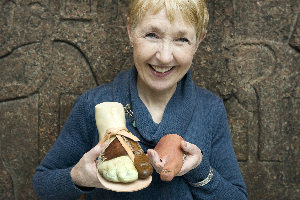The results of scientific tests using replicas of two ancient Egyptian artificial toes, including one that was found on the foot of a mummy, suggest that they’re likely to be the world’s first prosthetic body parts.
University of Manchester researcher, Dr Jacky Finch, has shown that a three-part wood and leather artefact housed in the Egyptian Museum in Cairo, along with a second one, the Greville Chester artificial toe on display in the British Museum, not only looked the part but also helped their toeless owners walk like Egyptians.

Credit: University of Manchester
The toes date from before 600 BC, predating what was hitherto thought to be the earliest known practical prosthesis – the Roman Capua Leg – by several hundred years.
The University of Manchester researcher Dr Jacky Finch wanted to find out if a three part wood and leather toe dating from between 950 to 710 BC found on a female mummy buried near Luxor in Egypt, and the Greville Chester artificial toe from before 600 BC and made of cartonnage (a sort of papier maché mixture made using linen, glue and plaster), could be used as practical tools to help their owners to walk. Both display significant signs of wear and their design features also suggest they may have been more than cosmetic additions.
Dr Finch says: “Several experts have examined these objects and had suggested that they were the earliest prosthetic devices in existence. There are many instances of the ancient Egyptians creating false body parts for burial but the wear plus their design both suggest they were used by people to help them to walk. To try to prove this has been a complex and challenging process involving experts in not only Egyptian burial practices but also in prosthetic design and in computerized gait assessment.”

When wearing the replicas the pressure measurements showed that for both volunteers there were no overly high pressure points. This indicated that the false toes were not causing any undue discomfort or possible tissue damage. However, when the volunteers wore just the replica sandals without the false toes the pressure being applied under the foot rose sharply.
Dr Finch says: “The pressure data tells us that it would have been very difficult for an ancient Egyptian missing a big toe to walk normally wearing traditional sandals. They could of course remained bare foot or perhaps have worn some sort of sock or boot over the false toe, but our research suggests that wearing these false toes made walking in a sandal more comfortable.”
Alongside the test data Dr Finch also asked her volunteers to fill in a questionnaire about how they felt when doing the trials in the gait laboratory. Despite it having performed well the comfort scores for the cartonnage replica were disappointing although it was felt to be an excellent cosmetic replacement. Describing the performance of the three part wooden and leather toe both volunteers found this one to be extremely comfortable, scoring it highly, one volunteer commenting that with time he could get used to walking in it.
Assessing the volunteers’ experience Dr Finch said: “It was very encouraging that both volunteers were able to walk wearing the replicas. Now that we have the gait analysis data and volunteer feedback alongside the obvious signs of wear we can provide a more convincing argument that the original artefacts had some intended prosthetic function.
Writing in February 2011 in the Lancet, Dr Finch said: “To be classed as true prosthetic devices any replacement must satisfy several criteria. The material must withstand bodily forces so that it does not snap or crack with use. Proportion is important and the appearance must be sufficiently lifelike as to be acceptable to both the wearer and those around them. The stump must also be kept clean, so it must be easy to take on and off. But most importantly it must assist walking.
She continued: “The big toe is thought to carry some 40% of the bodyweight and is responsible for forward propulsion, although those without it can adapt well. To accurately determine any level of function requires the application of gait analysis techniques involving integrated cameras and pressure devices placed along a walkway.”
The findings from this study, which have been published in full in the Journal of Prosthetics and Orthotics, means the earliest known prosthetic is now more likely to come from ancient Egypt. The three part example pre-dates by some 400 years what is currently thought to be the oldest, although untested, prosthetic device. This is a bronze and wooden leg that was found in a Roman burial in Capua, Southern Italy. That has been dated to 300 BC although only a replica now remains as the original was destroyed in a bombing raid over London during the war.
Copy of Roman Capua Leg



